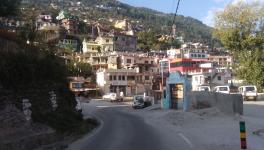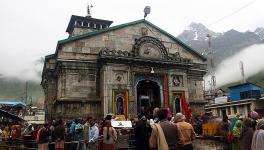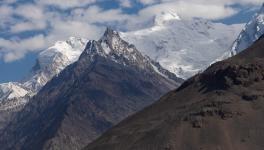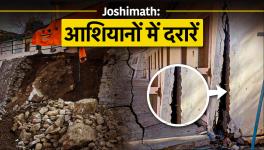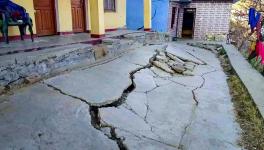Why Reports on Joshimath Sinking Have Made its Residents Nervous
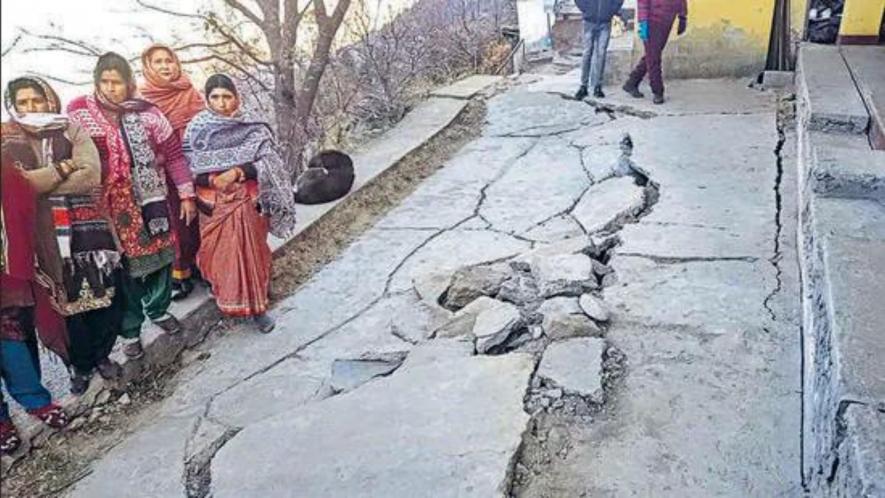
Image Courtesy: PTI
The seriousness of the crisis in the subsidence-ridden Joshimath town of Uttarakhand cannot be underestimated. The technical reports produced by eight scientific organisations on this subsidence have finally been released to the public after a Nainital High Court order.
These reports—by the Central Building Research Institute, Geological Survey of India, Wadia Institute of Himalayan Geology, National Geophysical Research Institute, Central Ground Water Board, Indian Institute of Remote Sensing, National Institute of Hydrology, and IIT Roorkee—highlight how Joshimath is sinking by 12 centimetres a year.
The Hyderabad-based National Geophysical Research Institute, a research laboratory of the Council of Scientific and Industrial Research, had warned that this hill town located in the Chamoli district has developed air-filled fissures which, in some places, are over 100 feet deep.
Such warnings should have immediately put the authorities on tenterhooks because Chamoli was the centre of a terrible earthquake in 1999 in which over 103 died, hundreds were injured, and thousands of houses were destroyed. Sadly, this does not seem to be the case.
A Wadia Institute of Himalayan Geology report has also warned that the cracks are likely to increase in the entire Chamoli district because it falls within a high seismic zone. Between January 12 and April 12, the Wadia Institute’s seismic network recorded 16 micro-earthquakes, which could be precursors for a bigger earthquake, their study has warned.
Given the seriousness of the situation, why has the National Institute of Hydrology (NIH), Roorkee, given a clean chit to the National Thermal Power Corporation (NTPC), which has been building the Vishnugad-Tapovan 520 MW hydropower project since 2004? The NIH report emphasises that water gushing in the Jaypee colony area of Joshimath had no connection with the aquifer leak caused by drilling for an approximately 15-kilometre-long tunnel as part of this project.
However, the NIH has not provided evidence to the contrary, which would confirm that this water is not flowing from the aquifer leak. Several leading scientists believe they should reveal solid proof to show otherwise, given that scientists who have studied this issue at length, including Dr Ravi Chopra, who heads the People’s Science Institute, insist there is a connection.
The NTPC’s hydropower project involves the construction of the roughly 15-km tunnel 900 metres below the surface. Part of it was being dug by multinational companies using a Tunnel Boring Machine or TBM. Unfortunately, the TBM got stuck on December 9 2009 and has remained stuck ever since. It also punctured an aquifer in a fault zone, which caused a massive discharge of high-pressure sub-surface water. Scientists estimated around 700 litres per second—enough to sustain a population of 20-30 lakh people per day—shot out in this discharge.
The NTPC did not attempt to stop this water. Since that day, the natural springs in Joshimath and surrounding villages started drying up, and water shortages are the norm.
Residents insist the problem of subsidence also started after the aquifer got punctured. Three leading geologists and scientists, Dr Bernard Miller, Dr Giorgio Hofer-Ollinger and Johan Brandt, studied this accident and published their findings in one of the eight “Engineering Geology for Society and Territory” volumes. They blamed unscientific drilling for the fractures in the rock, which allowed the water to gush out.
Geologist Dr SA Sati asks why none of the eight specialised scientific and technical institutions—tasked by the government to study the subsidence in and around Joshimath and propose solutions—have referred to this critical study. “They have come up with no new findings and simply airbrushed this key study by international scientists,” says Dr Sati.
Dr Ravi Chopra also says these studies say cracks appeared in houses because they were constructed along the “spring line”, or where springs flow. “But they failed to establish any new source for this problem,” he says.
Why the Geological Survey of India (GSI), one of these eight scientific institutions, has also given the NTPC project a clean chit is a mystery. The GSI report says Joshimath’s subsidence is clearly linked to the subsurface water in the form of numerous springs in its western part.
But in 2005, when the NTPC project had just kick-started, the GSI had been critical of it. A subsequent report by geologist Dr APS Bisht and Piyoosh Rautela in May 2010, titled “Disaster Looms Large Over Joshimath,” included those observations. Rautela is, at present, the executive director at the Uttarakhand State Disaster Management Authority. This report was peer-reviewed in Current Science.
Read More: NDMA Report Flags Joshimath’s Capacity, Recommends Construction Freeze
tul Sati, who spearheads the Joshimath Bachao Sangharsh Samiti, expresses concern over the ‘clean chit’. “We believe the underground aquifer is now practically empty, and that is the root cause of the subsidence problem,” he says.
In January, the Nainital High Court banned all construction in and around Joshimath. But after the GSI and NIH all-clear, NTPC has filed a writ petition in the Nainital High Court demanding interim relief to resume blasting and other construction work at Vishnugad-Tapovan.
The court has asked NTPC to approach the National Disaster Management Authority, which has to decide this crucial matter within two weeks.
Oddly, the NDMA prepared a 150-page summary of findings submitted to the central government, which seeks a complete ban on construction in the area.
Atul Sati is highly critical of how the government concealed this report from the public for six months.
“It is extremely questionable why scientists who put together this information were not allowed to place their studies in the public domain. These are esteemed scientific bodies, and their insights would have proved extremely useful for the public living in the Himalayas,” he says.
He says NTPC has been given a green signal because if questions are raised about Vishnugad-Tapovan, naturally, other hydropower projects, many near the Nanda Devi Biosphere, the source of several glaciers, would also come under the microscope.
Members of the Joshimath Bachao had sent samples of the water oozing from the cracks in Joshimath to laboratories in Ahmedabad and Kolkata to test if it matched the water in the aquifer—both laboratories refused to test the samples. Perhaps they did not want to rub the government the wrong way.
Dr Ranjit Kumar Sinha, who heads the Uttarakhand State Disaster Management Authority, said in a recent interview that a Detailed Project Report—to rehabilitate Joshimath residents and retrofit the salvageable homes—is being prepared based on these scientific reports. It would require funds to the tune of Rs 1,800 crore, from which the central government had agreed to provide Rs 1,465 crore.
He said the homes in Joshimath had been categorised as ‘green’, ‘red’ and ‘yellow’, and only those found unsafe—in the red—might be demolished. Yellow homes would likely need retrofitting, while the green category homes are considered safe.
However, the majority of residents in Joshimath are not reassured. Since the NTPC has sought interim relief, the beleaguered inhabitants are anxious. They recall how, in June, Chief Minister Pushkar Singh Dhami’s decision to allow blasting to resume at the Helang-Marwari bypass site put homes on the southern side of Joshimath at even more risk.
Several Joshimath residents told this reporter the government has minimised the extent of subsidence, especially after a statement in January by the Chief Secretary, Sukhbir Singh Sandu, that the area “affected by subsidence was around 350 metres.”
Dr Chopra visited Joshimath in January and reported seeing “thousands of cracks in homes”. According to him, around 40% of the town was affected. “That means a very sizeable section of the population,” he says.
Still, all eight reports emphasise that the hills around Joshimath are extremely ecologically sensitive. Not just Joshimath, numerous settlements in the region and across Uttarakhand face the risk of subsidence.
Joshimath is a test case for the State government. If it fails to take steps to resolve this crisis in Joshimath, chances are, it will fail in all other cities and villages in this Himalayan state.
The author is an independent journalist. The views are personal.
Get the latest reports & analysis with people's perspective on Protests, movements & deep analytical videos, discussions of the current affairs in your Telegram app. Subscribe to NewsClick's Telegram channel & get Real-Time updates on stories, as they get published on our website.









